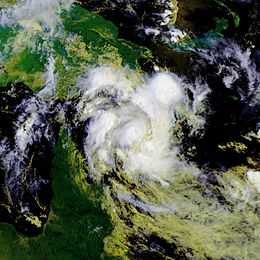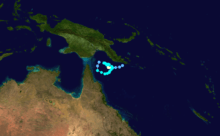Cyclone Guba
| Category 3 severe tropical cyclone (Aus scale) | |
|---|---|
| Category 1 (Saffir–Simpson scale) | |
 Cyclone Guba near Papua New Guinea on November 15 | |
| Formed | November 13, 2007 |
| Dissipated | November 20, 2007 |
| Highest winds |
10-minute sustained: 140 km/h (85 mph) 1-minute sustained: 140 km/h (85 mph) Gusts: 175 km/h (110 mph) |
| Lowest pressure | 970 mbar (hPa); 28.64 inHg |
| Fatalities | 149 total[1] |
| Damage | $71.4 million (2007 USD) |
| Areas affected | Papua New Guinea |
| Part of the 2007-08 Australian region cyclone season | |
Cyclone Guba (JTWC designation: 02P, also known as Severe Tropical Cyclone Guba) was a tropical cyclone that resulted in 149 fatalities and severe damage across southeastern Papua New Guinea. The first named cyclone of the 2007-08 Australian region cyclone season, Guba formed on November 13, 2007 close to the island of New Guinea, and reached tropical cyclone intensity the next day by the Tropical Cyclone Warning Centre (TCWC) in Brisbane, with the TCWC in Port Moresby assigning the name Guba. It meandered in the northern Coral Sea for the next week, strengthening to a Category 3 severe tropical cyclone on November 16. It posed a threat to the Australian Cape York Peninsula, but remained offshore, and finally dissipated on November 20.
Meteorological history

The Tropical Cyclone Warning Centre (TCWC) in Brisbane began issuing warnings on a developing tropical low located near the southern Papua New Guinea mainland on November 13, 2007,[2] while the Joint Typhoon Warning Center (JTWC) issued a Tropical Cyclone Formation Alert on the storm.[3] Later that day, the JTWC issued its first advisory, designating the low as Tropical Cyclone 02P.[4] TCWC Brisbane initiated tropical cyclone advices on the tropical low early on November 14, with a cyclone watch declared for the northern coastal and island communities in the Cape York Peninsula. Shortly after, TCWC Brisbane upgraded the system to Tropical Cyclone Guba, a name assigned by the TCWC in Port Moresby.[5] The name Guba is a boy's name in Papua New Guinea meaning 'a rain squall on the sea'.[6] Guba drifted erratically off the Queensland coast for the next two days, and cyclone warnings were cancelled when TCWC Brisbane expected the cyclone to remain slow-moving. Guba began drifting southwards and intensified on November 16, becoming a Category 3 severe tropical cyclone. Guba was a small, but intense system, forming a well-defined eye. Guba began weakening on November 17 and was downgraded to a Category 2. After downgraded to a Category 1 cyclone on November 18, it started to accelerate to the west towards the Queensland coast. Cyclone watches and warnings were declared again on November 19 as the cyclone was expected to move closer to the coast and intensify. This did not materialise, however, as Guba then turned northwards later that day, avoiding the Australian mainland, then northeast while it continued to weaken. TCWC Brisbane downgraded Guba below tropical cyclone strength, and issued its last advisory early on November 20.
Impact
As a tropical low, the precursor to Guba brought torrential rains to portions of Papua New Guinea, leading to widespread landslides and flooding. The most severe damage took place in Oro Province where 149 people were confirmed to have been killed by the storm.[1] Damage from the storm was believed to have exceeded 500 million kina ($177 million USD).[7]
Flooding in Papua New Guinea led to at least 200 deaths.[8][9] In the Oro Province, about 2,000 people were evacuated as a result of the flooding.[10] Roads, bridges and 40 houses were washed away, as tides in the area reached two metres high.[11] In the provincial capital, Popondetta, the water supply and electrical infrastructure was damaged, and road access was blocked.[12] Papua New Guinea's national airline, Air Niugini, suspended flights to Popondetta's main airport. The Rabaraba district in Milne Bay Province was also hit by flooding, with 30 houses and food gardens washed away, and forcing the evacuation of about 100 people.[10] The government in Papua New Guinea reported that an estimated 145,000 people were affected from the flooding in Oro Province.[12] Six days of torrential rain led to a damage total of 200 million kina ($71.4 million USD).[11] The torrential rain was the worst seen in the region in 30 years, according to the local people.[13]
Aftermath
The Papua New Guinea government declared a state of emergency in Oro Province and gave 50 million kina to help the province's communities. The Papua New Guinea Defence Force and local United Nations officials will assist in the relief, rehabilitation and reconstruction efforts.[11] Australia donated A$1 million in humanitarian relief to the affected regions. Five Royal Australian Air Force aircraft, three Australian Army helicopters a Royal Australian Navy landing craft and other Australian Defence Force personnel were sent to Papua New Guinea to assist in the relief; along with supplies which include water purification tablets, water containers, emergency shelters, blankets and generators. The AusAID organised a mission to assess the damage to infrastructure and to report priority relief needs.[14]
Naming
Severe Tropical Cyclone Guba, with a minimum pressure of 970 hPa (mbar), was the second weakest cyclone within the South Pacific, that either the Tropical Cyclone Warning Center in Brisbane, Australia or the Regional Specialized Meteorological Centre in Nadi, Fiji had monitored in the south Pacific that season.
This was the first time that a cyclone had been called Guba anywhere in the world. The name Guba was retired by the World Meteorological Organization and was replaced with the name Malia.[15] This was because tropical cyclones rarely form in TCWC Port Moresby Area of Responsibility and when a cyclone does form it automatically gets its name retired.[16]
Guba was the first tropical cyclone to be assigned a name from Port Moresby's name lists since Tropical Cyclone Epi in 2003. It is the first cyclone to occur in the Queensland region in the month of November since 1977.[17]
See also
- List of notable tropical cyclones
- Timeline of the 2007–08 Australian region cyclone season
References
- ↑ 1.0 1.1 "Papua New Guinea: Cyclone Guba Final Report" (PDF). International Federation of Red Cross and Red Crescent Societies. May 29, 2009. Retrieved August 30, 2010.
- ↑ Gale Warning for North Eastern Area: Tropical Low. Bureau of Meteorology (November 13, 2007). Retrieved on November 15, 2007.
- ↑ Tropical Cyclone Formation Alert. Joint Typhoon Warning Center (November 13, 2007). Retrieved on November 15, 2007.
- ↑ Tropical Cyclone 02P Warning NR 001. Joint Typhoon Warning Center (November 13, 2007). Retrieved on November 15, 2007.
- ↑ Gale Warning for North Eastern Area: Tropical Cyclone Guba. Bureau of Meteorology (November 14, 2007). Retrieved on November 15, 2007.
- ↑ Johnson, Leonie. "First cyclone named", Townsville Bulletin, November 14, 2007. Retrieved on November 14, 2007.
- ↑ Emma O'Brien (November 20, 2007). "Papua New Guinea Calls State of Emergency as 70 Die in Floods". Bloomberg News. Retrieved August 30, 2010.
- ↑ "RA V Twelfth Session report"
- ↑ "Aid due to reach PNG flood victims soon"
- ↑ 10.0 10.1 Australian Associated Press (2007). "Guba kills three in Papua New Guinea". Retrieved 2007-11-16.
- ↑ 11.0 11.1 11.2 "At least 71 dead in PNG floods say officials", Agence France-Presse, November 19, 2007. Retrieved on November 19, 2007.
- ↑ 12.0 12.1 Most recent disaster declaration: Papua New Guinea cyclone. United States Agency for International Development. ReliefWeb. Retrieved on November 22, 2007.
- ↑ Australian aid worker arrives in PNG to assist the humanitarian relief effort following Cyclone Guba. Oxfam. ReliefWeb. Retrieved on November 22, 2007.
- ↑ Humanitarian relief for Papua New Guinea. Australian Agency for International Development. ReliefWeb. Retrieved on November 22, 2007.
- ↑ "Tropical Cyclone names". World Meteorological Organization. Retrieved 2008-09-04.
- ↑ "Tropical Cyclone Operational Plan for the South Pacific and South-East Indian Ocean" (PDF). WMO. 2006. Retrieved 2008-08-15.
- ↑ "Cyclone Guba stews under southery drift", Brisbane Times, November 15, 2007. Retrieved on November 16, 2007.
| ||||||||||